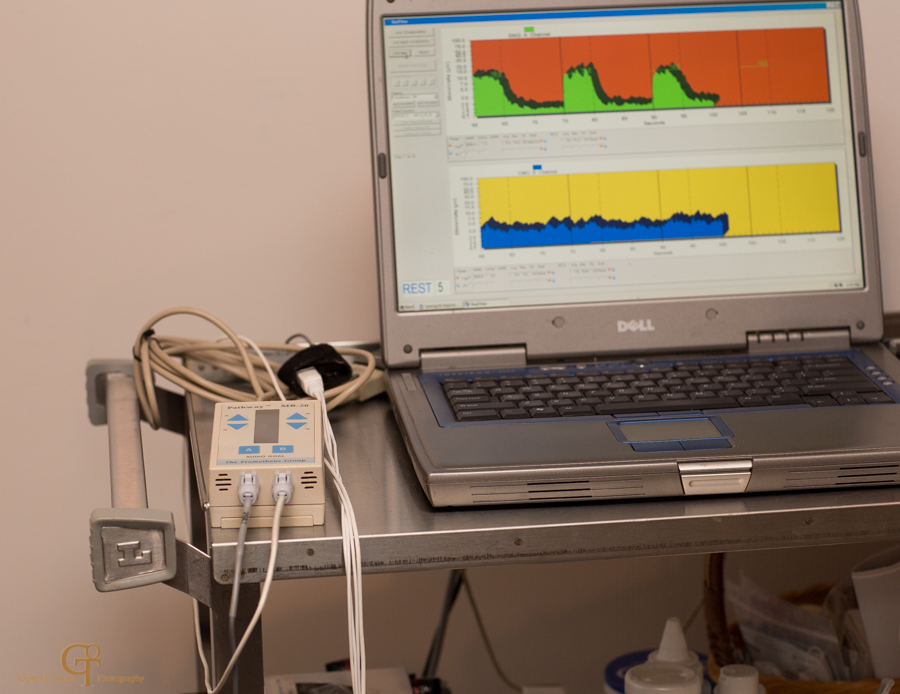Biofeedback
Biofeedback
Biofeedback is used to help relax muscles and calm the nervous system. It is commonly used to ease muscle tension and pain anywhere in the body from head to toe, including the pelvic floor muscles. Some examples of when biofeedback would be used for muscle tension include:

- Muscle Tension Headaches
- Migraine Headaches
- TMJ Pain
- Whiplash
- Anxiety Reactions
- Thoracic Outlet Syndrome
- Overuse Conditions
- Fibromyalgia
- Insomnia
- Raynaud’s Syndrome
- RSD (Reflex Sympathetic Dystrophy)
- Pelvic Pain
Biofeedback is also used in conjunction with active exercise to strengthen muscles. Muscles weaken and may require assistance with reactivating a muscle contraction. Biofeedback is a helpful procedure to relearn how to engage the muscle with the desired motion. The following are indications for the use of biofeedback”
- Accident or Injury
- Repetitive Trauma
- After Any Surgery
- Illness
- Chronic Pain
- Postural Pain
- Pregnancy
- Labor and Delivery
- Pelvic Floor Weakness
- Incontinence
- Post Prostatectomy Incontinence
Muscles of the head, jaw, neck, and back are easily visible making relaxation or contraction of the muscle less challenging. Since pelvic floor muscles are not visible externally, people often have a hard time locating the muscle group when trying to perform muscle contractions or movement. Biofeedback gives a person the information they need about muscles by measuring electrical activity within the muscle and displaying the activity on a computer screen.
Related to the pelvic floor
Biofeedback can be used either internally or externally depending on clinician and patient preference, availability and patient comfort. Internal sensors are inserted intravaginally or intrarectally. Externally, electrodes are placed on the skin near the anus, where pelvic floor muscles are closest to the surface, in order to provide an accurate reading. The second set of electrodes is often placed across the abdominal wall or the gluteal muscles (buttocks) secondary to the tendency to incorrectly activate abdominal muscles or the buttocks during pelvic floor contractions.
Often, men and women unknowingly carry increased tension in their pelvic floor, which causes the pelvic floor musculature to become actively insufficient, preventing an appropriate contraction. Biofeedback can be an effective tool a therapist can use to increase a patient’s awareness of this unnecessary tension. With biofeedback, patients can see when muscles are involuntarily producing electrical activity and can consequently work with the therapist to train those muscles to relax, thereby decreasing dysfunction.

When pelvic floor muscles are weakened, clinicians can use biofeedback as an adjunct therapy to pelvic floor muscle exercises to ensure proper contractions to promote strengthening. Because many patients have little to no awareness or control over their pelvic floor, they tend to compensate by using their abdominals, gluteus maximus or hip adductors when attempting to perform a contraction. To avoid this compensation and ensure accurate muscle retraining and motor control, therapists can use biofeedback – and the second electrodes along the abdominal wall specifically – to provide auditory or visual feedback to demonstrate first the inappropriate contraction of the abdominal muscles and then an appropriate contraction of the correct weakened muscle. Both the internal and external sensors record which muscles are contracting, how strong that contraction is, and how long a patient can hold the contraction. A physical therapist can use this information to pinpoint the root of the problem and develop a treatment plan and home program specific to each patient.


